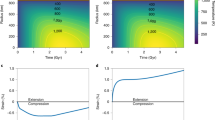Abstract
A thin outer ice shell on Jupiter's large moon Europa would imply easy exchange between the surface and any organic or biotic material in its putative subsurface ocean1,2,3,4. The thickness of the outer ice shell is poorly constrained, however, with model-dependent estimates ranging from a few kilometres5,6 to ten or more kilometres7. Here I present measurements of depths of impact craters on Europa, Ganymede and Callisto that reveal two anomalous transitions in crater shape with diameter. The first transition is probably related to temperature-dependent ductility of the crust at shallow depths (7–8 km on Europa). The second transition is attributed to the influence of subsurface oceans on all three satellites3,8,9, which constrains Europa's icy shell to be at least 19 km thick. The icy lithospheres of Ganymede and Callisto are equally ice-rich, but Europa's icy shell has a thermal structure about 0.25–0.5 times the thicknesses of Ganymede's or Callisto's shells, depending on epoch. The appearances of the craters on Europa are inconsistent with thin-ice-shell models1 and indicate that exchange of oceanic and surface material could be difficult.
This is a preview of subscription content, access via your institution
Access options
Subscribe to this journal
Receive 51 print issues and online access
$199.00 per year
only $3.90 per issue
Buy this article
- Purchase on Springer Link
- Instant access to full article PDF
Prices may be subject to local taxes which are calculated during checkout


Similar content being viewed by others
References
Greenberg, R. Tides and the biosphere of Europa. Am. Sci. 90, 48–55 (2002)
Pappalardo, R. et al. Does Europa have a subsurface ocean? Evaluation of the geologic evidence. J. Geophys. Res. 104, 24015–24056 (1999)
Kivelson, M. et al. Galileo magnetometer measurements: A stronger case for a subsurface ocean on Europa. Science 289, 1340–1343 (2000)
Zimmer, C., Khurana, K. & Kivelson, M. Subsurface oceans on Europa and Callisto: Constraints from Galileo magnetometer observations. Icarus 147, 329–347 (2000)
Greenberg, R., Geissler, P., Tufts, B. R. & Hoppa, G. Habitability of Europa's crust: The role of tidal-tectonic processes. J. Geophys. Res. 105, 17551–17562 (2000)
Hoppa, G., Tufts, B. R., Greenberg, R. & Geissler, P. Formation of cycloidal features on Europa. Science 285, 1899–1903 (1999)
Rathbun, J., Musser, G. & Squyres, S. Ice diapirs on Europa: Implications for liquid water. Geophys. Res. Lett. 25, 4157–4160 (1998)
Kivelson, M., Khurana, K. & Volwerk, M. Icarus (in the press)
Kivelson, M. et al. Europa and Callisto: Induced or intrinsic fields in a periodically varying plasma environment. J. Geophys. Res. 104, 4609–4625 (1999)
McKinnon, W. Convective instability in Europa's floating ice shell. Geophys. Res. Lett. 26, 951–954 (1999)
Pike, R. in Mercury (eds Vilas, F., Chapman, C. & Matthews, M.) 165–273 (Univ. Arizona Press, Tucson, 1988)
Schenk, P. Ganymede and Callisto: Complex crater formation and planetary crusts. J. Geophys. Res. 96, 15635–15664 (1991)
McKinnon, W. & Melosh, H. J. Evolution of planetary lithospheres: Evidence from multiring basins on Ganymede and Callisto. Icarus 44, 454–471 (1998)
Moore, J. M. et al. Large impact features on Europa: Results from the Galileo nominal mission. Icarus 135, 127–145 (1998)
Moore, J. M. et al. Large impact features on Europa: Results from the Galileo GEM mission. Icarus 151, 93–111 (2001)
Turtle, E. & Pierazzo, E. Thickness of a Europan ice shell from impact crater simulations. Science 294, 1326–1328 (2001)
Williams, K. & Zuber, M. Measurement and analysis of lunar basin depths from Clementine data. Icarus 131, 107–122 (1998)
Melosh, H. J. Impact Cratering (Oxford Press, Oxford, 1989)
Schenk, P. Central pit and dome crater: Exposing the interiors of Ganymede and Callisto. J. Geophys. Res. 98, 7475–7498 (1993)
Schenk, P. & Ridolfi, F. Morphology and scaling of ejecta deposits on icy satellites. Geophys. Res. Lett. (in the press)
Dombard, A. & McKinnon, W. Long-term retention of impact crater topography on Ganymede. Geophys. Res. Lett. 27, 3663–3666 (2000)
Durham, W., Kirby, S. & Stern, L. Creep of water ices under planetary conditions: A compilation. J. Geophys. Res. 102, 16293–16301 (1997)
Turtle, E. & Ivanov, B. Numerical simulations of crater excavation and collapse on Europa: Implications for ice thickness. Lunar Planet. Sci. XXXIII abstr. no. 1431 (2002).
Melosh, H. J. & Gaffney, E. Acoustic fluidization and the scale dependence of impact crater morphology. J. Geophys. Res. 88, A830–A834 (1983)
McKinnon, W. & Schenk, P. Estimates of comet fragment masses from impact crater chains on Callisto and Ganymede. Geophys. Res. Lett. 22, 1829–1832 (1995)
Anderson, J., Lau, E., Sjogren, W., Schubert, G. & Moore, W. Gravitational constraints on the internal structure of Ganymede. Nature 384, 541–543 (1996)
Anderson, J. et al. Shape, mean radius, gravity field and internal structure of Callisto. Icarus 153, 157–161 (2001)
Passey, Q. & Shoemaker, E. in Satellites of Jupiter (ed. Morrison, D.) 379–433 (Univ. Arizona Press, Tucson, 1982)
Collins, G., Head, J., Pappalardo, R. & Spaun, N. Evaluation of models for the formation of chaotic terrain on Europa. J. Geophys. Res. 105, 1709–1716 (2000)
Acknowledgements
This work was supported by NASA Planetary Geology and Geophysics.
Author information
Authors and Affiliations
Corresponding author
Ethics declarations
Competing interests
The author declares that he has no competing financial interests.
Rights and permissions
About this article
Cite this article
Schenk, P. Thickness constraints on the icy shells of the galilean satellites from a comparison of crater shapes. Nature 417, 419–421 (2002). https://doi.org/10.1038/417419a
Received:
Accepted:
Issue Date:
DOI: https://doi.org/10.1038/417419a
This article is cited by
-
Planned Geological Investigations of the Europa Clipper Mission
Space Science Reviews (2024)
-
Salts and organics on Ganymede’s surface observed by the JIRAM spectrometer onboard Juno
Nature Astronomy (2023)
-
Convection in a volatile nitrogen-ice-rich layer drives Pluto’s geological vigour
Nature (2016)
-
The missing large impact craters on Ceres
Nature Communications (2016)
Comments
By submitting a comment you agree to abide by our Terms and Community Guidelines. If you find something abusive or that does not comply with our terms or guidelines please flag it as inappropriate.



